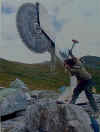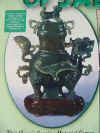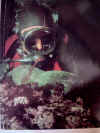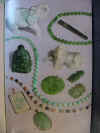|
ANIMAL
ITEMS:
Alaska Carvings & Travels
Alaska
Artifacts
Animal Carvings-Other
Australian
Art
Bronze Works
Bug & Crab Specimens
Exotic Leather Accessories
Gator Items
Gem Animals
Narwhal Tusks
Parasite
Wood Carvings
Safari Animal
Mounts
Sawfish bills
Shark Items
Shark Jaws
Tagua Nut Carvings
Teak Carvings
JEWELRY
ITEMS
Amber Items
Brooches
Cameos
Czech
brooches
Dichroic Glass
Jewelry
Earrings
Eyeglass Holders
Fairy Stone Crosses
Hatpins
Key chains
Maori Fish Hook Necklaces
Music
Jewelry
Necklaces
Opals &, Ivory Items
Pendants
Rings
Titanium
Jewelry
Vintage
Jewelry
FOSSIL ITEMS
Cave Bear Fossils
Dinosaur
Fossils
Mammoth
Fossils
Fossils-Others
Poop Fossils
Poop-Moose & Deer
Fossil Shark Teeth
CLOSEOUT
SALES:
Marbles
Closeout
Sales-Other
ROCK ITEMS
Meteorites
Rocks & Mineral-Other
OTHER COOL
STUFF FOR SALE
Alien Gifts
Boxes boxes
Gemstone
skulls
Indian
Artifacts
Medallions & Coins
Swords,
Daggers, Knives
The Weirdest
Zoo
books & Books
HUMAN
INTEREST
About Us
Cool
Customers
Jesse Nusbaum, Artist
Latest
Travels
2013 Travel America
Newsletter
Support Our Troops
Tina Memorial
Zany & Fun
FOLLOW us on TWITTER for
special DISCOUNTS



| |
You are on Gem Animals Page 10
Click to: Page 1 Page
2 Page 3 Page 4
Page 5
Page 6 Page 7 Page 8
Page 9
Contents: Jade
article
| Info
on Jade from British Columbia, Canada |
|
 
Here's the location of this awesome Polar Jade mine in British Columbia, Canada,
25 air miles east of Dease Lake, and a
photo of the mine.
 
Here's pictures of the size of jade boulders being cut, and the 72" diamond
saw they use to
cut them! This nephrite jade is harder than any other yet found, and
extremely popular for carving. The owner of the mine has sold over 2400
tons of the 4000 tons he's mined. Pieces like the above are shipped to China, where they are carved and
shipped back here as "Made in China"! This is top quality
nephrite jade gemstone. British Columbia used to be under water, where
calcium merged with serpentine, and pressure & heat from the depths of the
ocean to create this jade. There is enough jade in these Kutcho mountains
to supply global needs for hundreds of years.
Stay tuned for jade carvings we
will add after our next Alaska trip!
|
|
WHAT
DO YOU KNOW ABOUT JADE? If
you've handled jade, you know the distinctive waxy feel of this gemstone unlike
any other. The translucent look and the variety of colors makes it an
ever-interesting gem to collect. The
first use of jade goes back thousands of years in China, Mexico and New
Zealand. "Jade" is a generic term, not the technical name of a
mineral. In fact, the Chinese called anything worth carving as "yu",
including nephrite, jadeite, serpentine, bowenite, marble or even
soapstone. The artistry was emphasized rather than the particular
gemstone. Later the Europeans decided to call the Chinese carvings
"jade". 
Most is "NEPHRITE
jade" and not particularly rare, as
it's even found in Alaska and Canada in abundance as you can see in the above
pictures of the jade mine in British Columbia. Gigantic "Monterey
Jade" or "Big Sur Jade" boulders exist off the coast of
California near those towns, for instance. 
Our Specimen of Big Sur Jade...okay okay so it's not a BOULDER, it's all we've
GOT...deal with it! 
Monterey or Big Sur Jade off the California coast. The book about
harvesting huge boulders from the sea is in the book "Jade Beneath the Sea
- a Diving Adventure" by Don Wobber. Nephrite is an intertwining
parallel formation of two fibrous crystal minerals - actinolite & tremolite
which makes this rock extremely tough. It can be nearly white if the
maganese mineral actinolite dominates, or if it contains more iron, green, gray
or black prevails. It is formed deep in the Earth's crust under intense
heat and pressure - for instance, New Zealand's nephrite deposits formed from a
collision between the Pacific floor plate and the Australian plate.
Nephrite can be carved so thin as to be nearly transparent. |

Some of the colors of Nephrite Jade. China's
nephrite jade dates back to 7000 B.C. where two rivers (the Black Jade River and
the White Jade River) carried jade down its length from the Kunlun Mountains,
where it was collected and carried thousands of miles on the "Jade
Road", now the Silk Road, to the cities where the carvers resided.
Once the surface and river jade was depleted, a 20-40 foot zone of
horneblende schist and gneiss was discovered on the slopes of the Kunlun
Mountains. It is so hard that hammers just bounce off of it, so a fire was
built against it, then the heated rock was dashed with water or vinegar to
fracture it so chunks could be pried loose, then the processed repeated over and
over. Only nephrite jade was found and used up to the 1600's A.D., when
the Burmese jadeite was discovered. Much
less common is "JADEITE", and Burma was the early prime source of this
beautiful rock for China. "JADEITE" is a mineral composed of
sodium, iron and aluminum silicate. Presence of chromium ions causes green
jadeite's color, the finest green known as "Imperial Jade", though
equally lovely are the hues of mauve, pink, orange, red and yellow, even
black. It is tough because of interlocking grains rather than
crystals. It is also formed under intense heat and pressure (the Burmese
jadeite comes from the Uru Valley, close by the collision zone between the India
and Asian crustal plates). The appearance of Jadeite on the market at
hundreds to tens of thousands of dollars a carat reduced nephrite jade down to a
few dollars a pound. |

A lovely carving of Jadeite. Another early source
of Jadeite was Guatemala - ancient
Olmec civilizations made large quantities of carvings in this translucent, high
quality jadeite, the source of which was lost until 1998, when a hurricane
caused landslides that uncovered veins and boulders of it. Some has
reached the marketplace, and we expect to see much more of this lovely gem
available as time goes on. |

Olmec Jadeite carving Confucius
(551-479 B.C.) described the "virtues of jade" that increased its
popularity even more, such virtues transferring to the person that wears
jade. Its toughness transmits intelligence, the ringing sound that jade
makes when struck grants the owner wisdom, jade's color denotes loyalty, white
being the purest of all virtues. The shape of a disc represented Heaven
and Earth. It is also considered an important burial item, credited with
"qi", the body's life force for the afterlife. Traditionally,
every body opening was plugged with jade in some way at burial to implement
this. No matter where you
are in the world, jade (nephrite or jadeite) is a well loved and appreciated
gemstone, whether it is worn as jewelry, appreciated as an intricately carved
piece of art, handled for its "virtues", or carried in a pocket as a
good luck piece. Everyone should own their own bit of jade.
More
specimens of slabs of jade on Rocks, page 9.
|
Click to: Page 1 Page
2 Page 3 Page 4
Page 5
Page 6 Page 7 Page 8
Page 9
|